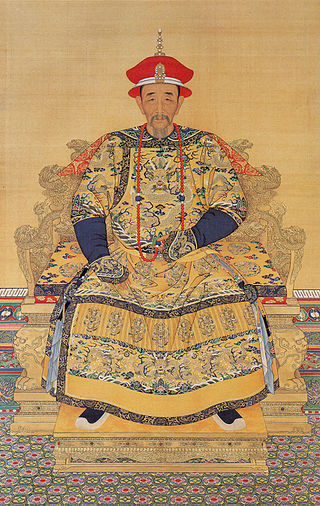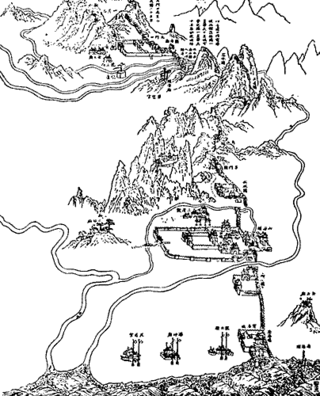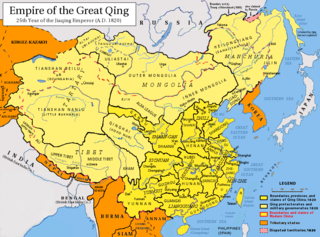| |||||
| Decades: | |||||
|---|---|---|---|---|---|
| See also: | Other events of 1680 History of China • Timeline • Years | ||||
Events from the year 1680 in China .
| |||||
| Decades: | |||||
|---|---|---|---|---|---|
| See also: | Other events of 1680 History of China • Timeline • Years | ||||
Events from the year 1680 in China .
The Eight Banners were administrative and military divisions under the Later Jin and Qing dynasties of China into which all Manchu households were placed. In war, the Eight Banners functioned as armies, but the banner system was also the basic organizational framework of all of Manchu society. Created in the early 17th century by Nurhaci, the banner armies played an instrumental role in his unification of the fragmented Jurchen people and in the Qing dynasty's conquest of the Ming dynasty.

The Kangxi Emperor, also known by his temple name Emperor Shengzu of Qing, personal name Xuanye, was the third emperor of the Qing dynasty, and the second Qing emperor to rule over China proper, reigning from 1661 to 1722.

Wu Sangui, courtesy name Changbai (長白) or Changbo (長伯), was a notorious Ming dynasty military officer who played a key role in the fall of the Ming dynasty and the founding of the Qing dynasty in China. In Chinese folklore, Wu Sangui is regarded as a disreputable Han Chinese traitor who played a pivotal role in several historical events, including the Battle of Shanhai Pass, Qing conquest of Ming China, the suppression of Southern Ming resistances and the execution of the Yongli Emperor, and eventually double-crossed both of his masters, the Ming and the Qing dynasties.

The Revolt of the Three Feudatories, also known as the Rebellion of Wu Sangui, was a rebellion in China lasting from 1673 to 1681, during the early reign of the Kangxi Emperor of the Qing dynasty (1644–1912). The revolt was led by the three lords of the fiefdoms in Yunnan, Guangdong and Fujian provinces against the Qing central government. These hereditary titles had been given to prominent Han Chinese defectors who had helped the Manchu conquer China during the transition from Ming to Qing. The feudatories were supported by Zheng Jing's Kingdom of Tungning in Taiwan, which sent forces to invade Mainland China. Additionally, minor Han military figures, such as Wang Fuchen and the Chahar Mongols, also revolted against Qing rule. After the last remaining Han resistance had been put down, the former princely titles were abolished.

The Green Standard Army was the name of a category of military units under the control of Qing dynasty in China. It was made up mostly of ethnic Han soldiers and operated concurrently with the Manchu-Mongol-Han Eight Banner armies. In areas with a high concentration of Hui people, Muslims served as soldiers in the Green Standard Army. After the Qing consolidated control over China, the Green Standard Army was primarily used as a police force.
The recorded military history of China extends from about 2200 BC to the present day. Chinese pioneered the use of crossbows, advanced metallurgical standardization for arms and armor, early gunpowder weapons, and other advanced weapons, but also adopted nomadic cavalry and Western military technology. China's armies also benefited from an advanced logistics system as well as a rich strategic tradition, beginning with Sun Tzu's The Art of War, that deeply influenced military thought.

Taranchi is a term denoting the Muslim sedentary population living in oases around the Tarim Basin in today's Xinjiang, China, whose native language is Turkic Karluk and whose ancestral heritages include Tocharians, Iranic peoples such as Sakas and Sogdians, and the later Turkic peoples such as the Uyghurs, Karluks, Yaghmas, Chigils, Basmyls, Tuhsis and lastly, the Mongolic tribes of the Chagatai Khanate.

Xinjiang is historically consisted of two main geographically, historically, and ethnically distinct regions with different historical names: Dzungaria north of the Tianshan Mountains; and the Tarim Basin south of the Tianshan Mountains, currently mainly inhabited by the Uyghurs. They were conquered by the Qing dynasty in the 18th century, and after the Dungan Revolt (1862–1877) the Qing reconquered both regions and integrated them into one province named Xinjiang in 1884.
During the late Zhou dynasty, the inhabitants of the Central Plains began to make a distinction between Hua and Yi, referred to be some historians as the Sino–barbarian dichotomy. They defined themselves as part of cultural and political region known as Huaxia, which they contrasted with the surrounding regions home to outsiders, conventionally known as the Four Barbarians. Although Yi is usually translated as "barbarian", other translations of this term in English include "foreigners", "ordinary others", "wild tribes" and "uncivilized tribes". The Hua–Yi distinction asserted Chinese superiority, but implied that outsiders could become Hua by adopting their culture and customs. These concepts were not unique to Ancient China, but were also applied by the Vietnamese, Japanese and Koreans who all considered themselves at one point in history to be "Middle Kingdom" in imitation of China.
The history of the Qing dynasty began in 1636, when Manchu chieftain Hong Taiji officially proclaimed the Qing dynasty, although the year 1644 is often considered the start of the dynasty's rule in China. The dynasty lasted until 1912, when Puyi abdicated the throne in response to the Xinhai Revolution in 1911. The final imperial dynasty of China, the Qing dynasty reached heights of power unlike any of the Chinese dynasties which preceded it, engaging in large-scale territorial expansion which ended with embarrassing defeat and humiliation to the foreign powers whom they believe to be inferior to them. The Qing dynasty's inability to successfully counter Western and Japanese imperialism ultimately led to its downfall, and the instability which emerged in China during the final years of the dynasty ultimately paved the way for the Warlord Era.

The transition from Ming to Qing or the Manchu conquest of China from 1618 to 1683 saw the transition between two major dynasties in Chinese history. It was a decades-long conflict between the emerging Qing dynasty, the incumbent Ming dynasty, and several smaller factions. It ended with the consolidation of Qing rule, and the fall of the Ming and several other factions.

Shang Zhixin was a warlord of the early Qing Dynasty, known for his role in the Revolt of the Three Feudatories. He was Prince of Pingnan, inheriting his position from his father Shang Kexi, who abandoned the Ming dynasty and surrendered to the Qing dynasty.

Zhao Yi was a poet, historian, and critic during the Qing dynasty in China. Zhao is notable for his innovative poetry, his historical writings, and for espousing unconventional views on various aspects of Chinese dynastic history.

The Dzungar–Qing Wars were a decades-long series of conflicts that pitted the Dzungar Khanate against the Qing dynasty and its Mongol vassals. Fighting took place over a wide swath of Inner Asia, from present-day central and eastern Mongolia to Tibet, Qinghai, and Xinjiang regions of present-day China. Qing victories ultimately led to the incorporation of Outer Mongolia, Tibet and Xinjiang into the Qing Empire that was to last until the fall of the dynasty in 1911–1912, and the genocide of much of the Dzungar population in the conquered areas.

The Qing dynasty (1636–1912) was established by conquest and maintained by armed force. The founding emperors personally organized and led the armies, and the continued cultural and political legitimacy of the dynasty depended on their ability to defend the country from invasion and expand its territory. Therefore, military institutions, leadership, and finance were fundamental to the dynasty's initial success and ultimate decay. The early military system centered on the Eight Banners, a hybrid institution that also played social, economic, and political roles. The Banner system was developed on an informal basis as early as 1601, and formally established in 1615 by Jurchen leader Nurhaci (1559–1626), the retrospectively recognized founder of the Qing. His son Hong Taiji (1592–1643), who renamed the Jurchens "Manchus," created eight Mongol banners to mirror the Manchu ones and eight "Han-martial" banners manned by Han troops who surrendered to the Qing before the full-fledged conquest of China proper began in 1644. After 1644, the Ming troops that surrendered to the Qing were integrated into the Green Standard Army, a corps that eventually outnumbered the Banners by three to one.
The Dzungar conquest of Altishahr resulted in the Tibetan Buddhist Dzungar Khanate in Dzungaria conquering and subjugating the Genghisid-ruled Chagatai Khanate in Altishahr. It put a final end to the independence of the Chagatai Khanate.

The Qing dynasty in Inner Asia was the expansion of the Qing dynasty's realm in Inner Asia in the 17th and the 18th century AD, including both Inner Mongolia and Outer Mongolia, both Manchuria and Outer Manchuria, Tibet, Qinghai and Xinjiang.
Events from the year 1663 in China. Also known as 壬寅 4359 or 4299 to 卯年 4360 or 4300 in the Earthly Branches calendar.
Events from the year 1679 in China.
Events from the year 1681 in China.